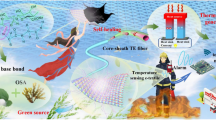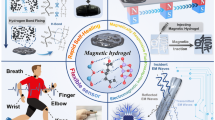Abstract
Magneto-sensitive elastomer (MSE) samples were fabricated by dispersing carbonyl iron particles into a rubber matrix. Velostat, which can be regarded as a pressure-sensitive material with piezoresistive properties, and the prepared MSE were selected to design a composite structure, referred to as a magnetic field detection unit (MFDU). The magneto-induced properties of the MFDU were investigated by using a self-built experimental system, and the effect of the constant and dynamic magnetic fields were studied. This MFDU can generate an output voltage signal in response to the magneto-induced resistance using an external DC power supply. It was found that the relationship between the normal force of the MSE and the magnetic field, and the resistance of Velostat can be changed by the magneto-induced normal force in the MFDU. The experimental results also proved that the output voltage of the MFDU is almost linearly dependent on the constant magnetic field and exhibits loading and unloading hysteretic time of about 20 ms and 40 ms, respectively, for the magnetic-induced output under a step magnetic field. Moreover, the obvious frequency-dependent output amplitude was observed under a pulsed magnetic field, and the possible mechanism for the magneto-sensitive performance of the MFDU was proposed and analyzed. The MFDU exhibited a stable response and good magneto-sensitive performance, which provides an approach for detecting external magnetic field.














Similar content being viewed by others
References
A. Guedes, G. Jaramillo, C. Buffa, G. Vigevani, S. Cardoso, D.C. Leitao, P.P. Freitas, and D.A. Horsley, Towards picotesla magnetic field detection using a GMR-MEMS hybrid device. IEEE. T. Magn. 48, 4115 (2012).
V.A. Popescu, Y.K. Prajapati, and A.K. Sharma, Highly sensitive magnetic field detection in infrared region with photonic spin hall effect in silicon waveguide plasmonic sensor. IEEE. T. Magn. 57, 1 (2021).
O.L. Sokol-Kutylovskii, Measurement of a weak variable magnetic field in an unshielded space. Meas. Tech. 64, 223 (2021).
Z.X. Liu, J.M. Chen, and X.D. Zou, Magnetic flux synchronous motion modulation for improving the low-frequency magnetic field detection limit of magnetoresistive sensor using MEMS resonators. IEEE. T. Magn. 58, 1 (2022).
S.M. Nalawade, R. Kitture, S.N. Kale, S. Gupta, and H.V. Thakur, Photonic crystal fiber injected with Fe3O4 nanofluid for magnetic field detection. Appl. Phys. Lett. 99, 161101 (2011).
P. Orr, P. Niewczas, M. Stevenson, and J. Canning, Compound phase-shifted fiber bragg structures as intrinsic magnetic field sensors. J. Lightwave. Technol. 28, 2667 (2010).
T.X. Nan, Y. Hui, M. Rinaldi, and N.X. Sun, Self-biased 215MHz magnetoelectric NEMS resonator for ultra-sensitive DC magnetic field detection. Sci. Rep. UK 3, 1985 (2013).
Y. Su, B.F. Zhang, Y. Zhu, and Y.Q. Li, Sensing circular birefringence by polarization-dependent parameters in fiber bragg gratings and the influence of linear birefringence. Opt. Fiber. Technol. 18, 51 (2012).
D. Ivaneyko, V. Toshchevikov, and M. Saphiannikova, Dynamic-mechanical behaviour of anisotropic magneto-sensitive elastomers. Polymer 147, 95 (2018).
Z.S. Yang, L.H. Tang, M.Y. Xie, S.S. Sun, W.H. Li, and K. Aw, Broadband nonlinear behaviour of a soft magneto-sensitive elastomer cantilever under low-frequency and low-magnitude excitation. J. Intel. Mat. Syst. Str. 29, 3165 (2018).
D. Romeis, V. Toshchevikov, and M. Saphiannikova, Effects of local rearrangement of magnetic particles on deformation in magneto-sensitive elastomers. Soft Matter 15, 3552 (2019).
X.C. Song, W.J. Wang, F.F. Yang, G.P. Wang, and X.T. Rui, The study of natural rubber/polybutadiene rubber hybrid matrix-based magnetorheological elastomer. J. Thermoplast. Compos. 35, 17 (2022).
C.J. Wu, Q.X. Zhang, X.P. Fan, Y.H. Song, and Q. Zheng, Smart magnetorheological elastomer peristaltic pump. J. Intel. Mat. Syst. Str. 30, 1084 (2019).
I. Bica, E.M. Anitas, and L. Chirigiu, Magnetic field intensity effect on plane capacitors based on hybrid magnetorheological elastomers with graphene nanoparticles. J. Ind. Eng. Chem. 56, 407 (2017).
A.K. Bastola, and L. Li, A new type of vibration isolator based on magnetorheological elastomer. Mater. Des. 157, 431 (2018).
A. Bellelli, and A. Spaggiari, Magneto-mechanical characterization of magnetorheological elastomers. J. Intel. Mat. Syst. Str. 30, 2534 (2019).
E. Burgaz, and M. Goksuzoglu, Effects of magnetic particles and carbon black on structure and properties of magnetorheological elastomers. Polym. Test. 81, 106233 (2020).
L. Chen, X.L. Gong, W.Q. Jiang, J.J. Yao, H.X. Deng, and W.H. Li, Investigation on magnetorheological elastomers based on natural rubber. J. Mater. Sci. 42, 5483 (2008).
J.H. Yoon, I.H. Yang, U.C. Jeong, K.H. Chung, J.Y. Lee, and J.E. Oh, Investigation on variable shear modulus of magnetorheological elastomer based on natural rubber due to change of fabrication design. Polym. Eng. Sci. 53, 992 (2013).
G.J. Liao, X.L. Gong, and S.H. Xuan, Influence of shear deformation on the normal force of magnetorheological elastomer. Mater. Lett. 106, 270 (2013).
G.J. Liao, X.L. Gong, S.H. Xuan, C.Y. Guo, and L.H. Zong, Magnetic-field-induced normal force of magnetorheological elastomer under compression status. Ind. Eng. Chem. Res. 51, 3322 (2012).
V.V. Sorokin, G.V. Stepanov, M. Shamonin, G.J. Monkman, A.R. Khokhlov, and E.Y. Kramarenko, Hysteresis of the viscoelastic properties and the normal force in magnetically and mechanically soft magnetoactive elastomers: effects of filler composition, strain amplitude and magnetic field. Polymer 76, 191 (2015).
F. Guo, C.B. Du, and G.J. Yu, The normal force characteristic of a novel magnetorheological elastomer based on butadiene rubber matrix compounded with the self-fabricated silly putty. Adv. Mater. Sci. Eng. 2021, 5831721 (2021).
A. Dzedzickis, E. Sutinys, V. Bucinskas, U. Samukaite-Bubniene, and I. Morkvenaite-Vilkonciene, Polyethylene-carbon composite (Velostat) based tactile sensor. Polymer 12, 2905 (2020).
D. Giovanelli and E. Farella, Force sensing resistor and evaluation of technology for wearable body pressure sensing. J. Sens. 2016, 9391850 (2016).
B.W. Lee and H. Shin, Feasibility study of sitting posture monitoring based on piezoresistive conductive film-based flexible force sensor. IEEE. Sens. J. 16, 15 (2016).
V. Kumar, B.C. Yeo, W.S. Lim, J.E. Raja, and K.B. Koh, Development of electronic floor mat for fall detection and elderly care. Asian. J. Sci. Res. 11, 344 (2018).
B. Ricardo, M. Angel, and B. Jesus, Development of an inexpensive sensor network for recognition of sitting posture. Int. J. Distrib. Sens. N. 2015, 1 (2015).
B.X. Ju and X.L. Wang, Magnetic field-dependent inductance properties based on magnetorheological elastomer. J. Cent. South. Univ. 29, 1075 (2022).
M. Hopkins, R. Vaidyanathan, and A.H. Mcgregor, Examination of the performance characteristics of velostat as an in-socket pressure sensor. IEEE. Sens. J. 20, 6992 (2020).
J.G. Simmons, Generalized formula for the electric tunnel effect between similar electrodes separated by a thin insulating film. J. Appl. Phys. 34, 1793 (1963).
S.H. Wu, Phase structure and adhesion in polymer blends: a criterion for rubber toughening. Polymer 26, 1855 (1985).
D. Gunther, D.Y. Borin, and S. Gunther, X-ray micro-tomographic characterization of field-structured magnetorheological elastomers. Smart. Mater. Struct. 21, 15005 (2012).
Y. Shen, M.F. Golnaraghi, and G.R. Heppler, Experimental research and modeling of magnetorheological elastomers. J. Intel. Mat. Syst. Str. 15, 27 (2004).
Acknowledgments
This work was supported by the General Program of Chongqing Natural Science Foundation (No. cstc2019jcyj-msxmX0005 and cstc2020jcyj-msxmX0425) and the China Postdoctoral Science Foundation (2021MD703913).
Author information
Authors and Affiliations
Corresponding author
Ethics declarations
The authors declare that they have no conflict of interest.
Additional information
Publisher's Note
Springer Nature remains neutral with regard to jurisdictional claims in published maps and institutional affiliations.
Rights and permissions
Springer Nature or its licensor (e.g. a society or other partner) holds exclusive rights to this article under a publishing agreement with the author(s) or other rightsholder(s); author self-archiving of the accepted manuscript version of this article is solely governed by the terms of such publishing agreement and applicable law.
About this article
Cite this article
Ju, B., Lv, B. & Fu, B. Magnetic Field Detection Unit Based on Composite Structure of Magneto-Sensitive Elastomer and Velostat. J. Electron. Mater. 52, 3291–3302 (2023). https://doi.org/10.1007/s11664-023-10298-w
Received:
Accepted:
Published:
Issue Date:
DOI: https://doi.org/10.1007/s11664-023-10298-w




